An Efficient Recursive Multibeam Pattern Subtraction (MPS) Beamformer for Planar Antenna Arrays Optimization
Abstract
:1. Introduction
1.1. Background and Motivation
1.2. Paper Contribution
1.3. Paper Organization
2. Multibeam Pattern Subtraction (MPS) Beamformer Modelling
3. Performance Analysis of the MPS Beamformer
3.1. Performance of MPS Beamformer with the Convergence Control Factor
3.2. Performance of MPS Beamformer with the Number of Multibeams
3.3. Performance of MPS Beamformer with the Number of Iterations
3.4. Impact of Array Rounded Corners Structures on the MPS Beamformer Performance
3.5. Performance of MPS Beamformer for Rectangular Arrays
3.6. Angular Scanning Performance of MPS Beamformer
4. Comparison between MPS Beamformer and Conventional Tapering Windows
5. Conclusions
Author Contributions
Funding
Acknowledgments
Conflicts of Interest
References
- Akyildiz, I.F.; Nie, S.; Lin, S.-C.; Chandrasekaran, M. 5G roadmap: 10 key enabling technologies. Comput. Netw. 2016, 106, 17–48. [Google Scholar] [CrossRef]
- Artiga, X.; Perruisseau-Carrier, J.; Pérez-Neira, A.I. Antenna array configurations for massive MIMO outdoor base stations. In Proceedings of the 2014 IEEE 8th Sensor Array and Multichannel Signal Processing Workshop (SAM), A Coruna, Spain, 22–25 June 2014; pp. 281–284. [Google Scholar] [CrossRef]
- Amani, N.; Bencivenni, C.; Glazunov, A.A.; Ivashina, M.V.; Maaskant, R. MIMO channel capacity gains in mm-wave LOS systems with irregular sparse array antennas. In Proceedings of the 2017 IEEE-APS Topical Conference on Antennas and Propagation in Wireless Communications (APWC), Verona, Italy, 1–15 September 2017; pp. 264–265. [Google Scholar] [CrossRef] [Green Version]
- Pałczyński, K.; Śmigiel, S.; Gackowska, M.; Ledziński, D.; Bujnowski, S.; Lutowski, Z. IoT Application of Transfer Learning in Hybrid Artificial Intelligence Systems for Acute Lymphoblastic Leukemia Classification. Sensors 2021, 21, 8025. [Google Scholar] [CrossRef] [PubMed]
- Hasan, M.Z.; Al-Rizzo, H. Beamforming Optimization in Internet of Things Applications Using Robust Swarm Algorithm in Conjunction with Connectable and Collaborative Sensors. Sensors 2020, 20, 2048. [Google Scholar] [CrossRef] [Green Version]
- Cray, B.A.; Kirsteins, I. A Comparison of Optimal SONAR Array Amplitude Shading Coefficients. Acoustics 2019, 1, 808–815. [Google Scholar] [CrossRef] [Green Version]
- Li, J.; Ma, Z.; Mao, L.; Wang, Z.; Wang, Y.; Cai, H.; Chen, X. Broadband Generalized Sidelobe Canceler Beamforming Applied to Ultrasonic Imaging. Appl. Sci. 2020, 10, 1207. [Google Scholar] [CrossRef] [Green Version]
- Wang, Y.; Yang, W.; Chen, J.; Kuang, H.; Liu, W.; Li, C. Azimuth Sidelobes Suppression Using Multi-Azimuth Angle Synthetic Aperture Radar Images. Sensors 2019, 19, 2764. [Google Scholar] [CrossRef] [Green Version]
- Ruiz-de-Azua, J.A.; Garzaniti, N.; Golkar, A.; Calveras, A.; Camps, A. Towards Federated Satellite Systems and Internet of Satellites: The Federation Deployment Control Protocol. Remote Sens. 2021, 13, 982. [Google Scholar] [CrossRef]
- Prabhu, K.M.M. Window Functions and Their Applications in Signal Processing; Taylor & Francis: London, UK, 2014. [Google Scholar]
- Lau, B.K.; Leung, Y.H. A Dolph-Chebyshev approach to the synthesis of array patterns for uniform circular arrays. In Proceedings of the 2000 IEEE International Symposium on Circuits and Systems, Geneva, Switzerland, 28–31 May 2000; Volume 1, pp. 124–127. [Google Scholar]
- Dessouky, M.; Sharshar, H.; Albagory, Y. An Approach for Dolph-Chebyshev Uniform Concentric Circular Arrays. J. Electromagn. Waves Appl. 2007, 21, 781–794. [Google Scholar] [CrossRef]
- Aljahdali, S.; Nofal, M.; Albagory, Y. A modified array processing technique based on Kaiser window for concentric circular arrays. In Proceedings of the 2012 International Conference on Multimedia Computing and Systems, ICMCS 2012, Tangiers, Morocco, 10–12 May 2012. [Google Scholar]
- Almagboul, M.A.; Shu, F.; Qian, Y.; Zhou, X.; Wang, J.; Hu, J. Atom search optimization algorithm based hybrid antenna array receive beamforming to control sidelobe level and steering the null. AEU Int. J. Electron. Commun. 2019, 111, 152854. [Google Scholar] [CrossRef]
- Neroni, M. Ant Colony Optimization with Warm-Up. Algorithms 2021, 14, 295. [Google Scholar] [CrossRef]
- Sharaqa, A.; Dib, N. Circular antenna array synthesis using firefly algorithm. Int. J. RF Microw. Comput. Aided Eng. 2014, 24, 139–146. [Google Scholar]
- Chakravarthy, V.; Rao, P.M. Circular array antenna optimization with scanned and unscanned beams using novel particle swarm optimization. Indian J. Appl. Res. 2015, 5, 790–793. [Google Scholar]
- Meng, X.; Liu, Y.; Gao, X.; Zhang, H. A New Bio-inspired Algorithm: Chicken Swarm Optimization. In Advances in Swarm Intelligence; Tan, Y., Shi, Y., Coello, C.A.C., Eds.; ICSI: Lecture Notes in Computer Science; Springer: Cham, Switzerland, 2014; Volume 8794. [Google Scholar] [CrossRef]
- Singh, U.; Salgotra, R. Synthesis of linear antenna array using flower pollination algorithm. Neural Comput. Appl. 2018, 29, 435–445. [Google Scholar] [CrossRef]
- Saxena, P.; Kothari, A. Optimal Pattern Synthesis of Linear Antenna Array Using Grey Wolf Optimization Algorithm. Int. J. Antennas Propag. 2016, 2016, 1205970. [Google Scholar] [CrossRef] [Green Version]
- Mehrabian, A.; Lucas, C. A novel numerical optimization algorithm inspired from weed colonization. Ecol. Inform. 2006, 1, 355–366. [Google Scholar] [CrossRef]
- Sun, G.; Liu, Y.; Chen, Z.; Zhang, Y.; Wang, A.; Liang, S. Thinning of concentric circular antenna arrays using improved discrete cuckoo search algorithm. In Proceedings of the 2017 IEEE Wireless Communications and Networking Conference (WCNC), San Francisco, CA, USA, 19–22 March 2017; pp. 1–6. [Google Scholar]
- Li, H.; Liu, Y.; Sun, G.; Wang, A.; Liang, S. Beam pattern synthesis based on improved biogeography-based optimization for reducing sidelobe level. Comput. Electr. Eng. 2017, 60, 161–174. [Google Scholar] [CrossRef]
- Van Luyen, T.; Giang, T.V.B. Interference Suppression of ULA Antennas by Phase-Only Control Using Bat Algorithm. IEEE Antennas Wirel. Propag. Lett. 2017, 16, 3038–3042. [Google Scholar] [CrossRef]
- Mirjalili, S.; Lewis, A. The Whale Optimization Algorithm. Adv. Eng. Softw. 2016, 95, 51–67. [Google Scholar] [CrossRef]
- Liang, S.; Fang, Z.; Sun, G.; Liu, Y.; Qu, G.; Zhang, Y. Sidelobe Reductions of Antenna Arrays via an Improved Chicken Swarm Optimization Approach. IEEE Access 2020, 8, 37664–37683. [Google Scholar] [CrossRef]
- Sun, G.; Liu, Y.; Li, H.; Liang, S.; Wang, A.; Li, B. An Antenna Array Sidelobe Level Reduction Approach through Invasive Weed Optimization. Int. J. Antennas Propag. 2018, 2018, 4867851. [Google Scholar] [CrossRef] [Green Version]
- Wei, T.; Wang, S.; Zhong, J.; Liu, D.; Zhang, J. A Review on Evolutionary Multi-Task Optimization: Trends and Challenges. IEEE Trans. Evol. Comput. 2021, 1. [Google Scholar] [CrossRef]
- Sahalos, J.N. Design of shared aperture radar arrays with minimum sidelobe level of the two-way array factor. IEEE Trans. Antennas Propag. 2020, 68, 5415–5420. [Google Scholar]
- Parker, M. Digital Signal Processing 101; Elsevier: Amsterdam, The Netherlands, 2010; pp. 201–211. ISBN 9781856179218. [Google Scholar] [CrossRef]
- Gangwar, V.S.; Singh, A.K.; Singh, S.P. An Effective Approach for the Synthesis of Unequally Spaced Antenna Array by Estimating Optimum Elements Density on the Aperture. IEEE Antennas Wirel. Propag. Lett. 2017, 16, 2278–2282. [Google Scholar] [CrossRef]
- Albagory, Y.; Alraddady, F. An Efficient Approach for Sidelobe Level Reduction Based on Recursive Sequential Damping. Symmetry 2021, 13, 480. [Google Scholar] [CrossRef]
- Albagory, Y. An Efficient Fast and Convergence-Controlled Algorithm for Sidelobes Simultaneous Reduction (SSR) and Spatial Filtering. Electronics 2021, 10, 1071. [Google Scholar] [CrossRef]
- Albagory, Y.; Alraddady, F. An Efficient Adaptive and Steep-Convergent Sidelobes Simultaneous Reduction Algorithm for Massive Linear Arrays. Electronics 2022, 11, 170. [Google Scholar] [CrossRef]
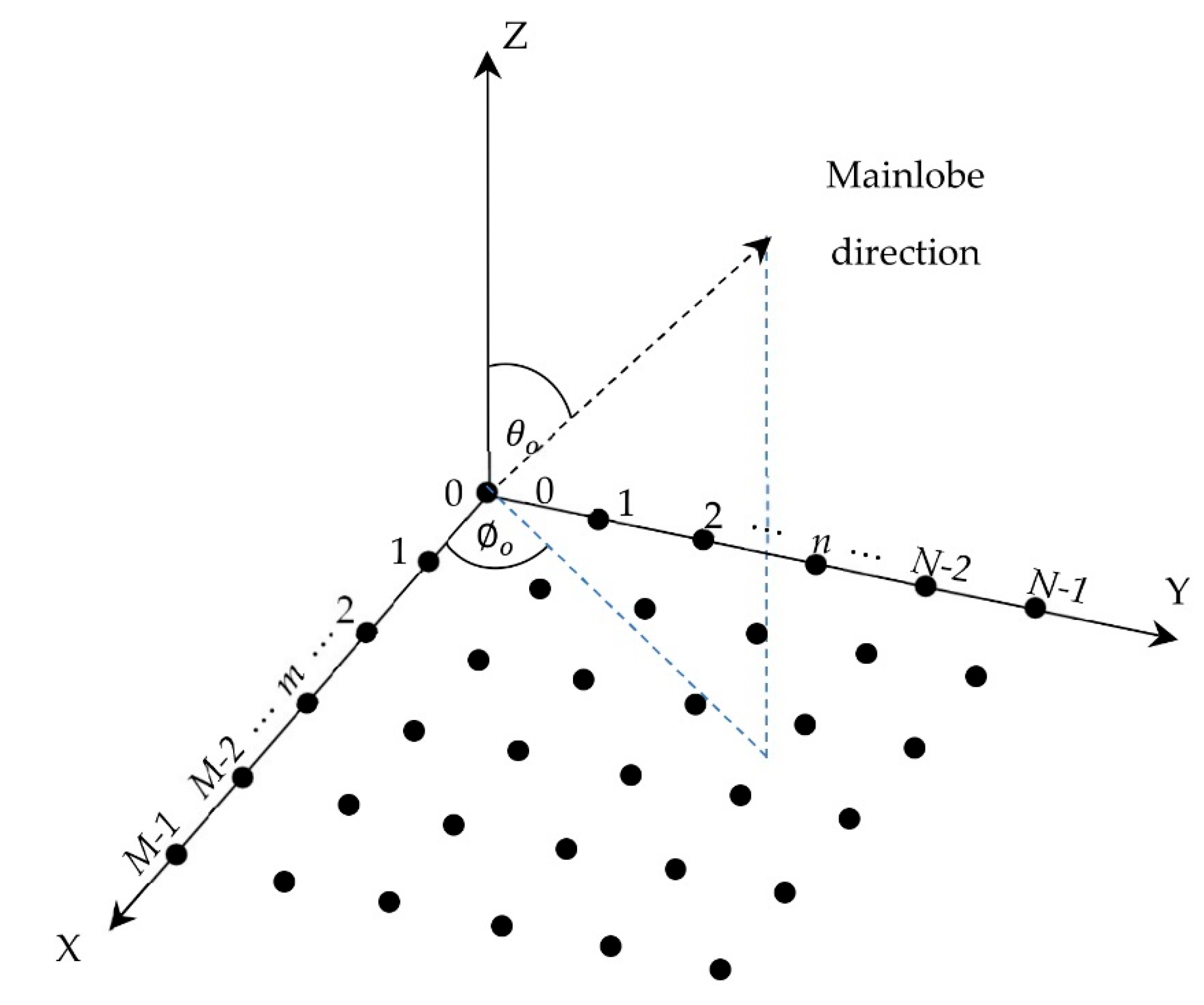


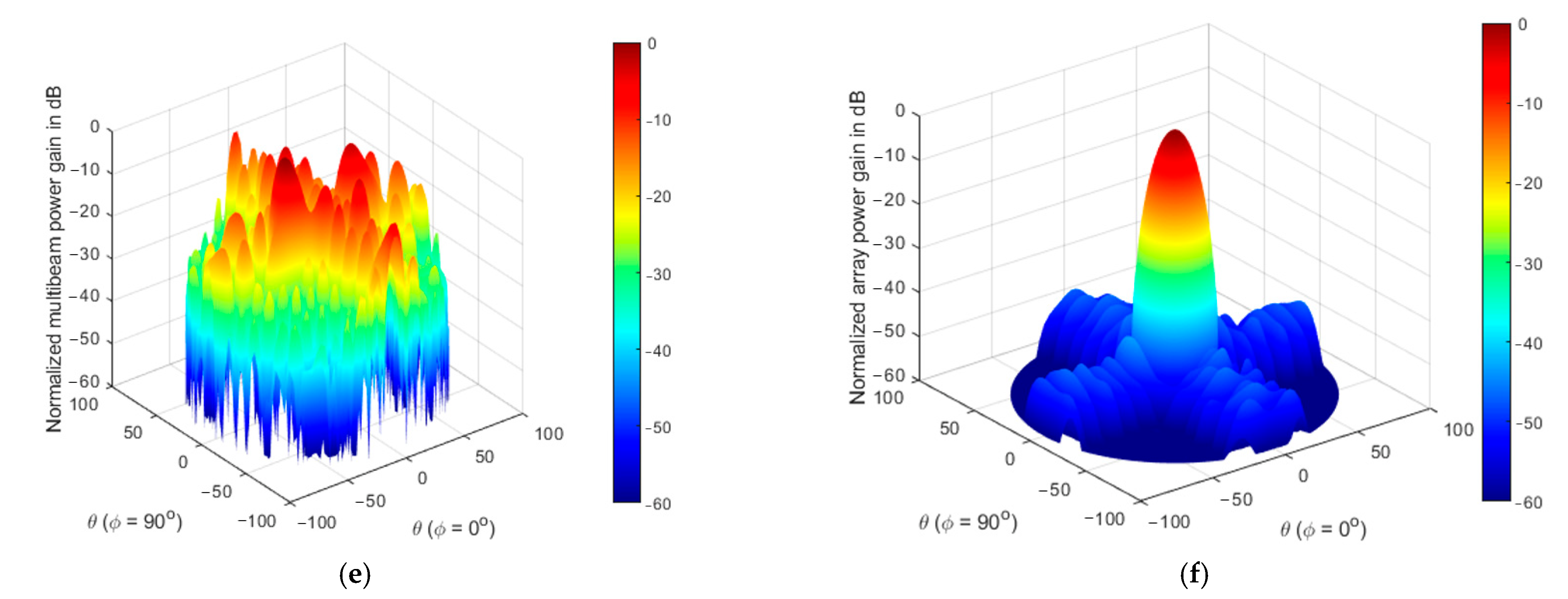
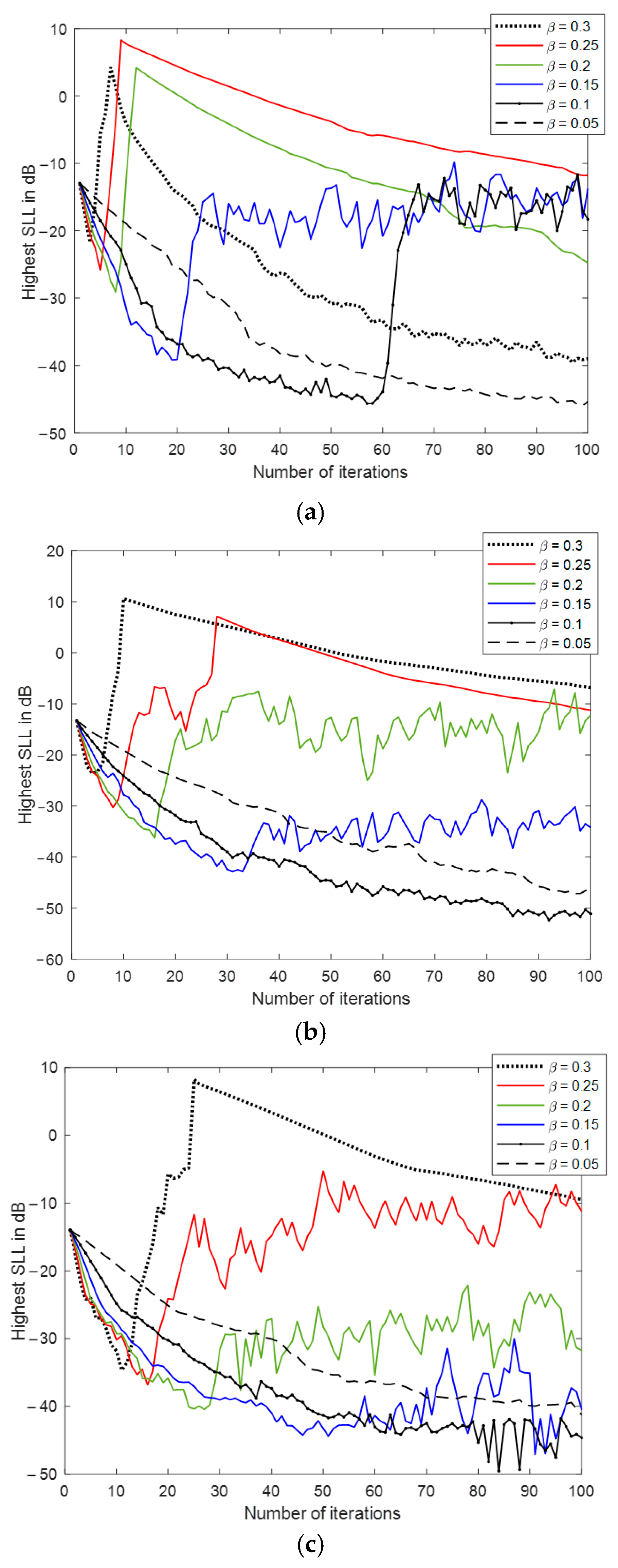
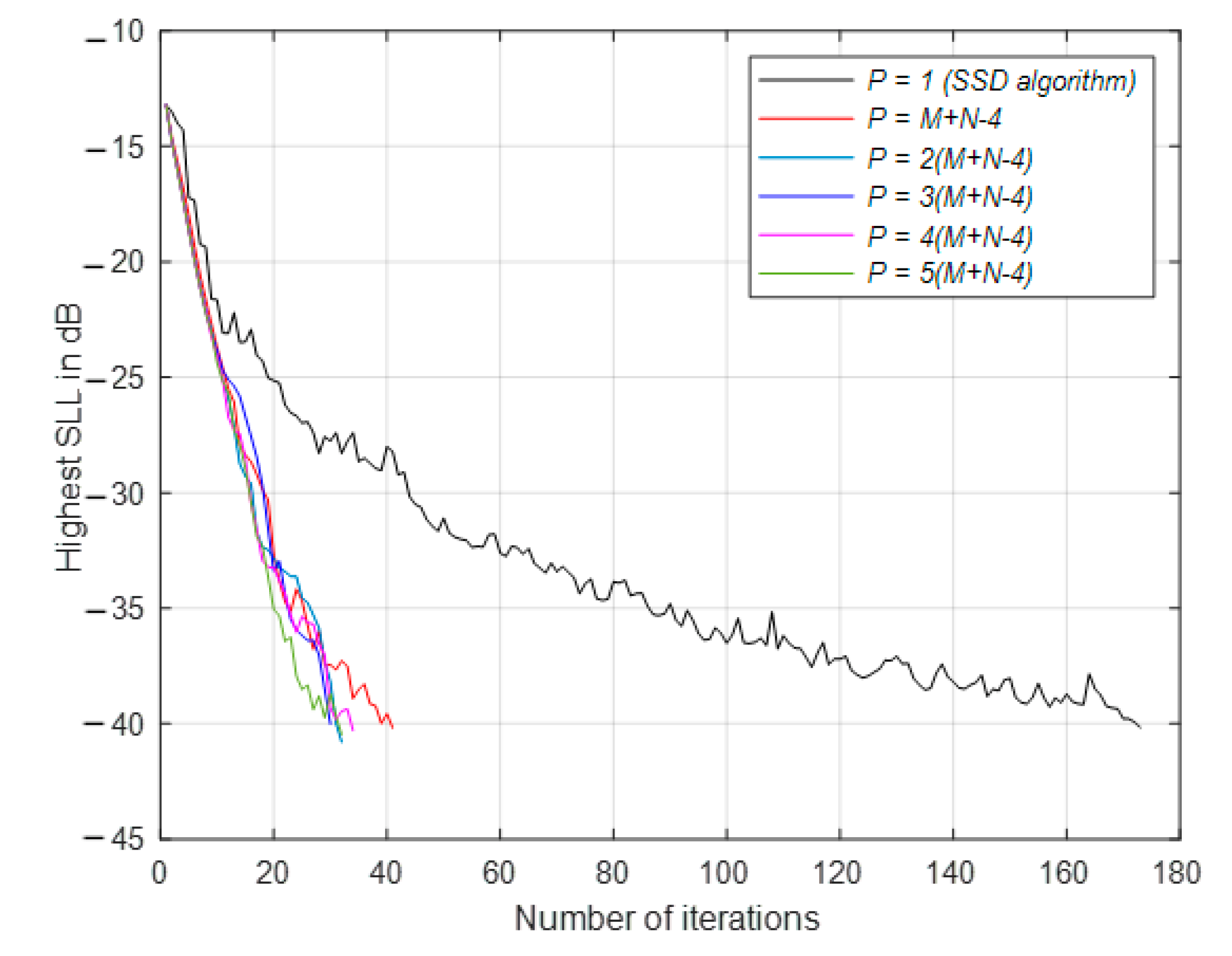
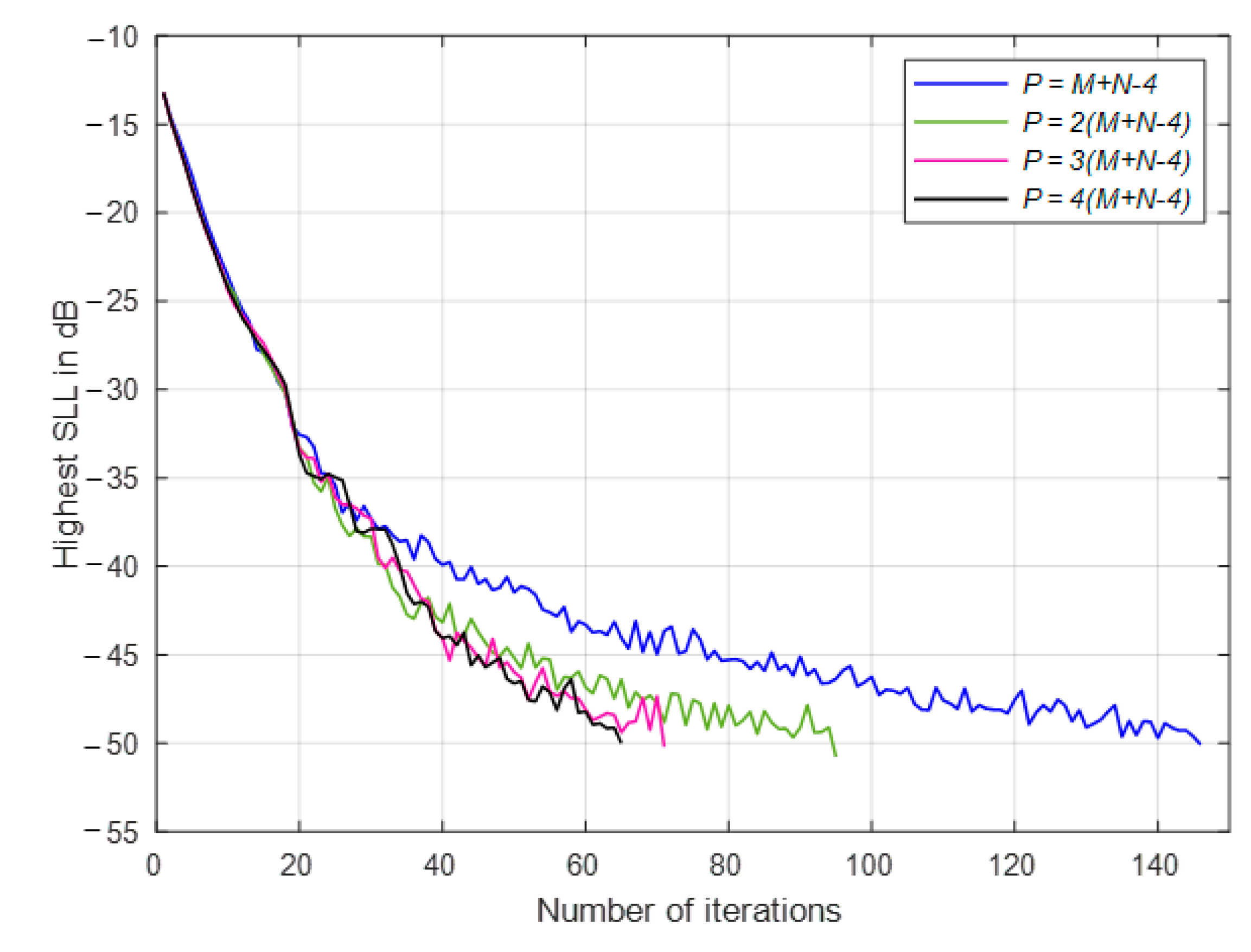
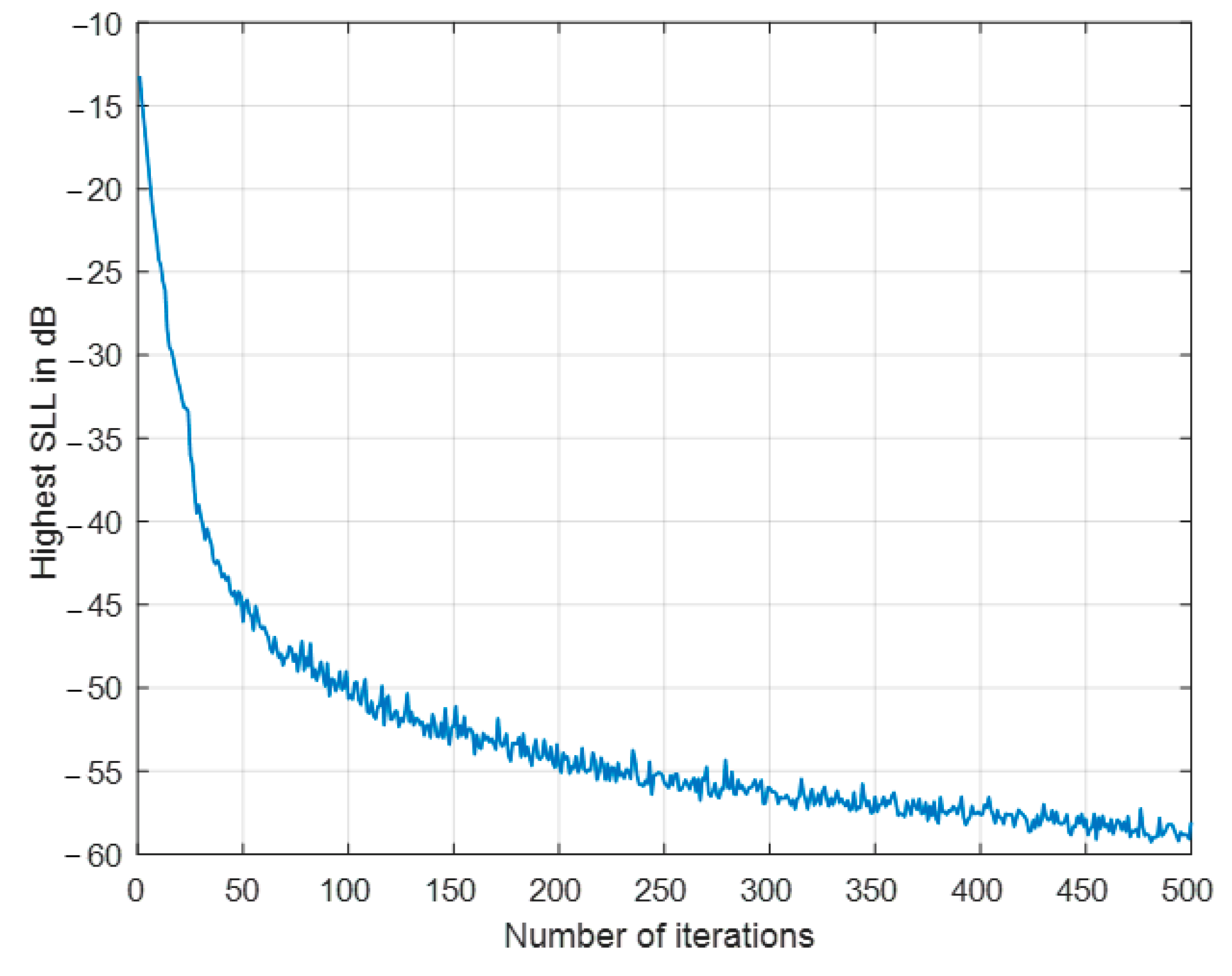
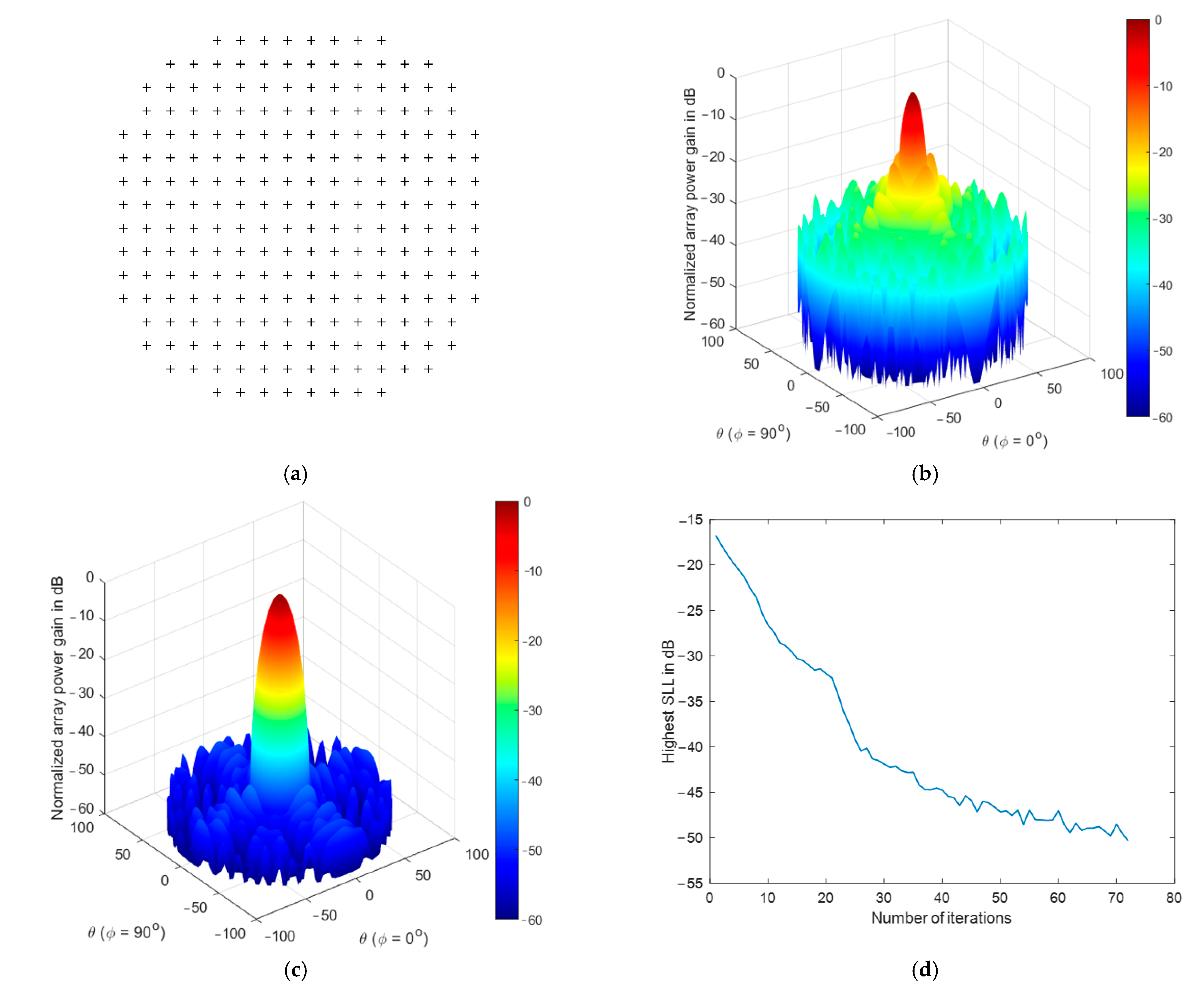
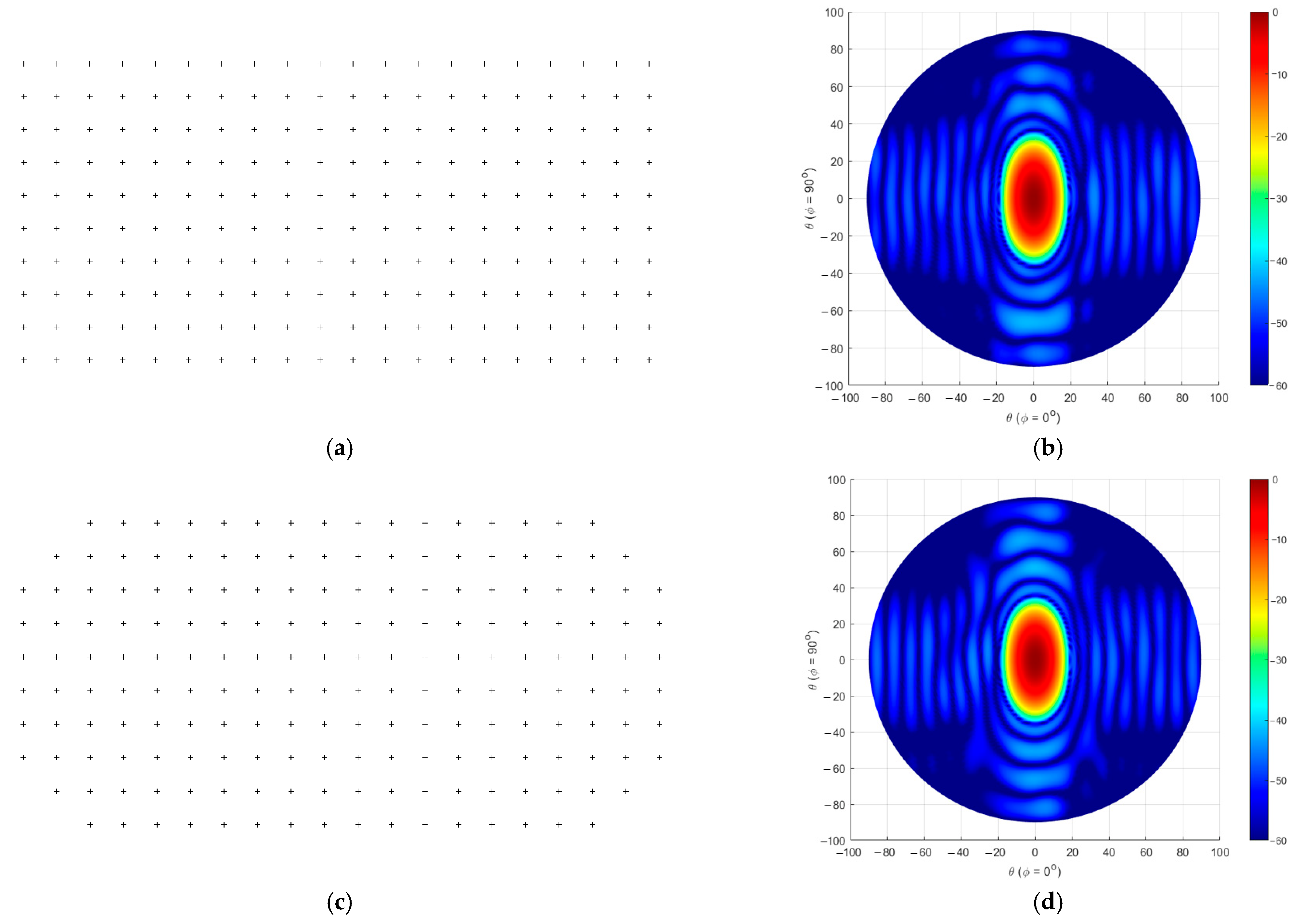
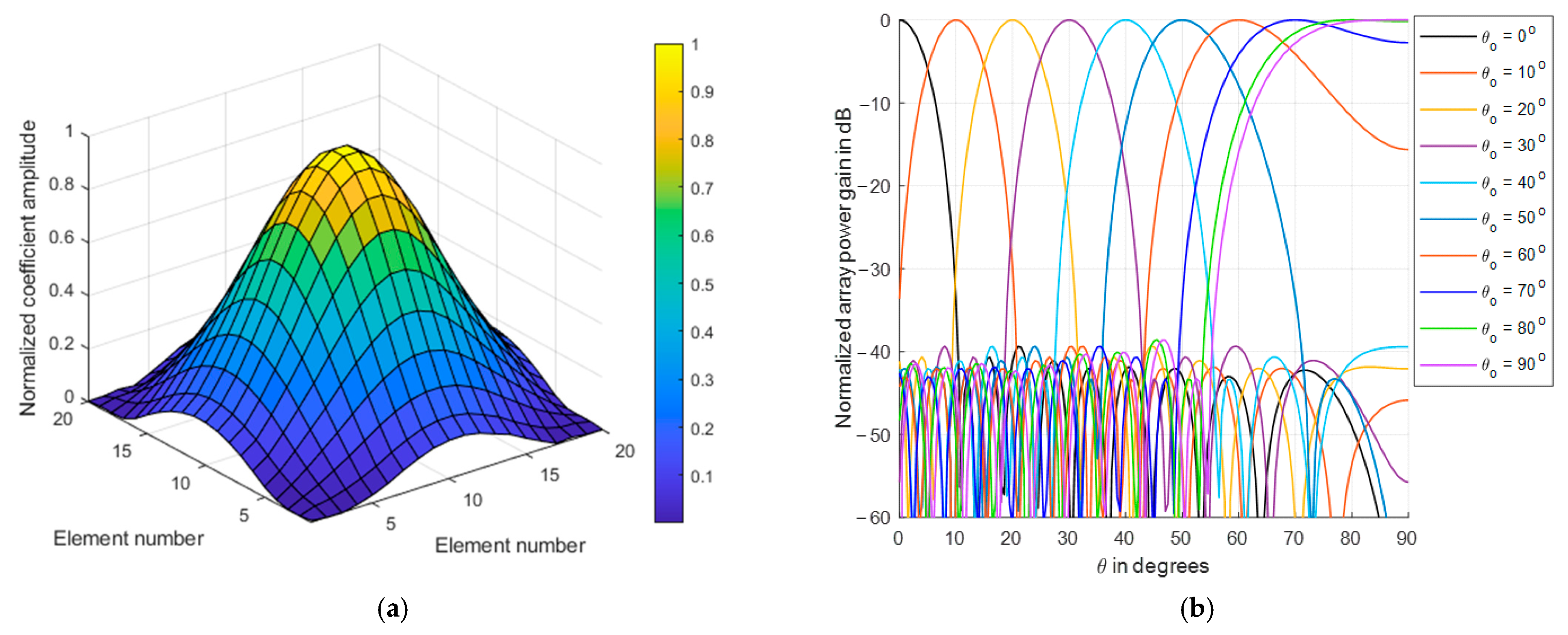

Publisher’s Note: MDPI stays neutral with regard to jurisdictional claims in published maps and institutional affiliations. |
© 2022 by the authors. Licensee MDPI, Basel, Switzerland. This article is an open access article distributed under the terms and conditions of the Creative Commons Attribution (CC BY) license (https://creativecommons.org/licenses/by/4.0/).
Share and Cite
Albagory, Y.; Alraddady, F. An Efficient Recursive Multibeam Pattern Subtraction (MPS) Beamformer for Planar Antenna Arrays Optimization. Electronics 2022, 11, 1015. https://doi.org/10.3390/electronics11071015
Albagory Y, Alraddady F. An Efficient Recursive Multibeam Pattern Subtraction (MPS) Beamformer for Planar Antenna Arrays Optimization. Electronics. 2022; 11(7):1015. https://doi.org/10.3390/electronics11071015
Chicago/Turabian StyleAlbagory, Yasser, and Fahad Alraddady. 2022. "An Efficient Recursive Multibeam Pattern Subtraction (MPS) Beamformer for Planar Antenna Arrays Optimization" Electronics 11, no. 7: 1015. https://doi.org/10.3390/electronics11071015
APA StyleAlbagory, Y., & Alraddady, F. (2022). An Efficient Recursive Multibeam Pattern Subtraction (MPS) Beamformer for Planar Antenna Arrays Optimization. Electronics, 11(7), 1015. https://doi.org/10.3390/electronics11071015







